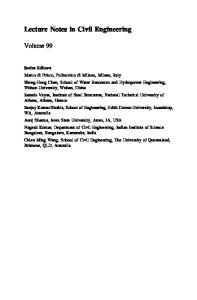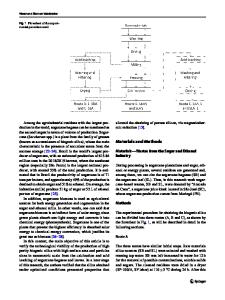Energy analysis of sugarcane bagasse after enzymatic catalysis process
- PDF / 1,067,931 Bytes
- 15 Pages / 595.276 x 790.866 pts Page_size
- 27 Downloads / 353 Views
ORIGINAL ARTICLE
Energy analysis of sugarcane bagasse after enzymatic catalysis process Leandro Cardoso de Morais 1 & Amanda Alves Domingos Maia 1 & Fábio Minoru Yamaji 2 & Sthefany Rodrigues Fernandes Viana 1 & Pedro Resende 3 Received: 12 August 2020 / Revised: 24 September 2020 / Accepted: 16 October 2020 # Springer-Verlag GmbH Germany, part of Springer Nature 2020
Abstract Nowadays, countries produce approximately 1700 million tons of sugarcane per year. However, many countries now find it difficult to produce sufficient energy, generating a relevant socioeconomic impact. The objective of this work is to study the potential energy of sugarcane bagasse after decomposing fungus process. This fungus, the basidiomycete Pleurotus ostreatus, acts in the bioconversion of lignocellulosic residues, through the decomposition of the solid substrate in a process of enzymatic catalysis. The activation energy, Ea, varied from 12 to 145 kJ/mol, and the calorific value and the fixed carbon obtained were 21 MJ/kg and 82.4%, respectively, values considered acceptable for a solid biofuel. In the results of the enzymatic analysis performed through the laccase secretion and manganese peroxidase (MnP), measured by the Fourier transform infrared spectroscopy technique (FT-IR), it is possible to identify when there was degradation of the lignin due to the methoxy group (CH3) elongation. Scanning electron microscope (SEM) analysis showed partially fragmented structures, which occurred due to catalysis and pyrolysis processes, respectively. Keywords Solid biofuel . Bioconversion . White-rot fungi . Pleurotus ostreatus . Sugarcane bagasse waste
1 Introduction Brazil is the largest producer of sugarcane in the world; according to data from the Ministry of Agriculture, Livestock and Supply of the Brazilian Government, the harvest 2018/ Statement of novelty This work was developed with the intention of improving the quality of the sugarcane bagasse, and for that, a lignin decomposing fungus was used with the objective of improving the characteristics of this residue, transforming it into a substrate with potential for use in heat generation and energy. * Leandro Cardoso de Morais [email protected] 1
Institute of Science and Technology, São Paulo State University (UNESP) “Júlio de Mesquita Filho” – Sorocaba Campus, Av. Três de Março, 511, Alto da Boa Vista, Sorocaba, São Paulo 18087-180, Brazil
2
Department of Forest Engineering, UFSCar – Federal University of São Carlos/Sorocaba Campus, Road João Leme dos Santos, km 110, SP –264, Bairro do Itinga, Sorocaba, SP 18052–780, Brazil
3
ProMetheus – Escola Superior de Tecnologia e Gestão, Instituto Politécnico de Viana do Castelo, 4900-347 Viana do Castelo, Portugal
2019 was about 643 million tons [1], and the bagasse generated from sugarcane milling is approximately 280 kg of bagasse per ton of sugarcane [2]. These quantities show the importance of studying the bioenergy potential of sugarcane bagasse residues. The use of biomass, especially those with a distinct energetic potenti
Data Loading...











